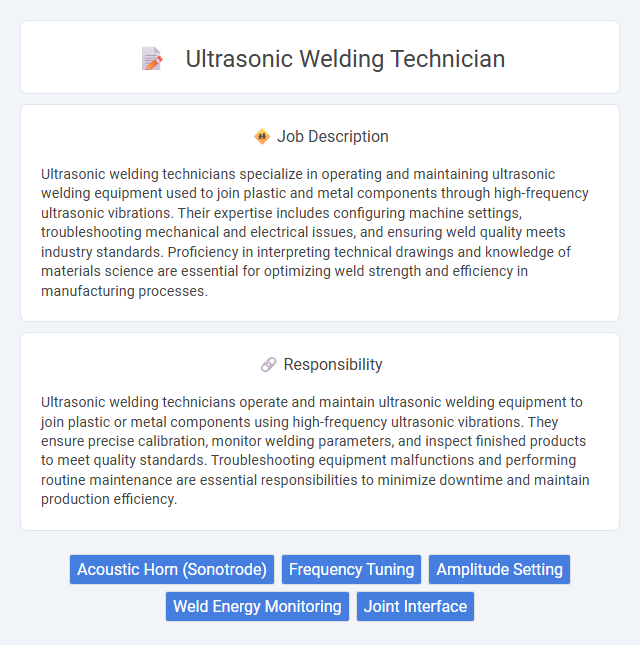
Ultrasonic welding technicians specialize in operating and maintaining ultrasonic welding equipment used to join plastic and metal components through high-frequency ultrasonic vibrations. Their expertise includes configuring machine settings, troubleshooting mechanical and electrical issues, and ensuring weld quality meets industry standards. Proficiency in interpreting technical drawings and knowledge of materials science are essential for optimizing weld strength and efficiency in manufacturing processes.
Individuals who have strong attention to detail and good hand-eye coordination are likely to excel as ultrasonic welding technicians. People who prefer working with precision tools and technology in controlled environments may find this role suitable. Those who struggle with repetitive tasks or require high physical activity might have less probability of thriving in this job.
Qualification
Ultrasonic welding technicians must possess strong technical skills in operating and maintaining ultrasonic welding equipment, typically requiring a background in mechanical or electrical engineering technology. Certifications in ultrasonic welding technology and hands-on experience with precision assembly processes improve job performance and career advancement. Proficiency in interpreting technical blueprints, understanding material properties, and ensuring quality control standards are essential qualifications for success in this role.
Responsibility
Ultrasonic welding technicians operate and maintain ultrasonic welding equipment to join plastic or metal components using high-frequency ultrasonic vibrations. They ensure precise calibration, monitor welding parameters, and inspect finished products to meet quality standards. Troubleshooting equipment malfunctions and performing routine maintenance are essential responsibilities to minimize downtime and maintain production efficiency.
Benefit
Ultrasonic welding technicians likely enjoy benefits such as competitive salaries and opportunities for career advancement within manufacturing industries. The role may provide skill development in advanced welding technologies, enhancing job security and marketability. Workers might also benefit from hands-on experience in high-tech equipment, contributing to professional growth and industry demand.
Challenge
Ultrasonic welding technicians likely face challenges involving the precise calibration and maintenance of complex equipment to ensure consistent weld quality. Troubleshooting unexpected variations in weld strength may require advanced technical skills and a strong understanding of material properties. The role probably demands continuous adaptation to evolving technologies and production requirements, posing ongoing problem-solving opportunities.
Career Advancement
Ultrasonic welding technicians develop specialized skills in operating high-frequency welding equipment used for precision joining of thermoplastics and metals, which enhances employability in manufacturing and automotive industries. Mastery of ultrasonic welding techniques enables progression to roles such as welding supervisor, quality control inspector, or technical trainer. Continuous certification and experience with advanced ultrasonic systems significantly increase opportunities for career advancement and higher salary prospects.
Key Terms
Acoustic Horn (Sonotrode)
An Ultrasonic Welding Technician specializes in operating and maintaining equipment that uses high-frequency ultrasonic vibrations to join materials, with a critical focus on the Acoustic Horn (Sonotrode). The sonotrode is a key component that transmits vibrational energy to the workpieces, requiring precise tuning and regular inspection to ensure optimal welding quality and consistency. Mastery of sonotrode materials, such as titanium or aluminum, and their wear patterns directly impacts the efficiency and durability of ultrasonic welds.
Frequency Tuning
Ultrasonic welding technicians specialize in frequency tuning to optimize welding performance and ensure precise bond quality in thermoplastic and metal components. They adjust ultrasonic frequencies, typically ranging from 20 kHz to 40 kHz, to match material properties and thickness, enhancing energy efficiency and minimizing defects. Proficiency in frequency modulation and calibration tools is essential for maintaining system integrity and achieving reliable, high-strength welds.
Amplitude Setting
Ultrasonic welding technicians specialize in setting the optimal amplitude to ensure precise energy delivery for strong, consistent welds in plastic and metal components. Accurate amplitude settings directly impact welding quality, affecting the fusion process by controlling vibration intensity and frequency during operation. Mastery of amplitude adjustment enhances production efficiency and reduces defect rates in high-volume manufacturing environments.
Weld Energy Monitoring
Ultrasonic welding technicians specialize in assembling thermoplastic and metal components by applying high-frequency ultrasonic vibrations to create precise, strong bonds. Weld energy monitoring plays a crucial role in ensuring the quality and consistency of each weld by measuring the total energy delivered during the welding process, allowing technicians to detect anomalies and maintain production standards. Expertise in calibrating ultrasonic welding equipment and analyzing weld energy data is essential for maximizing product reliability and minimizing defects in industries such as automotive, medical device manufacturing, and electronics assembly.
Joint Interface
An ultrasonic welding technician specializes in the precise alignment and preparation of the joint interface to ensure optimal energy transmission and material bonding. Mastery in controlling parameters such as pressure, amplitude, and weld time is crucial for achieving a strong, defect-free joint interface. Expertise in inspecting and maintaining the joint interface quality directly impacts the durability and performance of ultrasonic welded assemblies.
 kuljobs.com
kuljobs.com